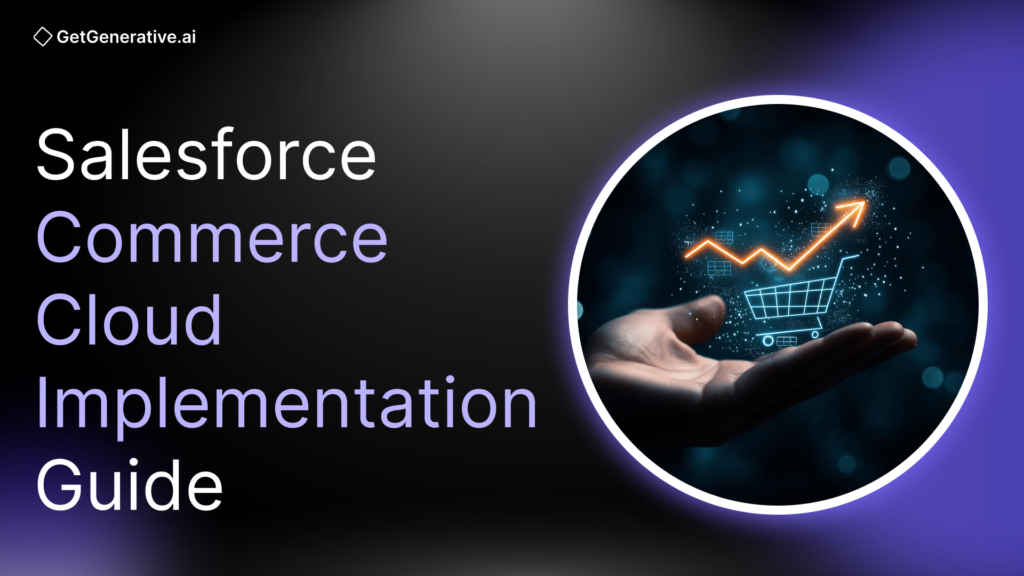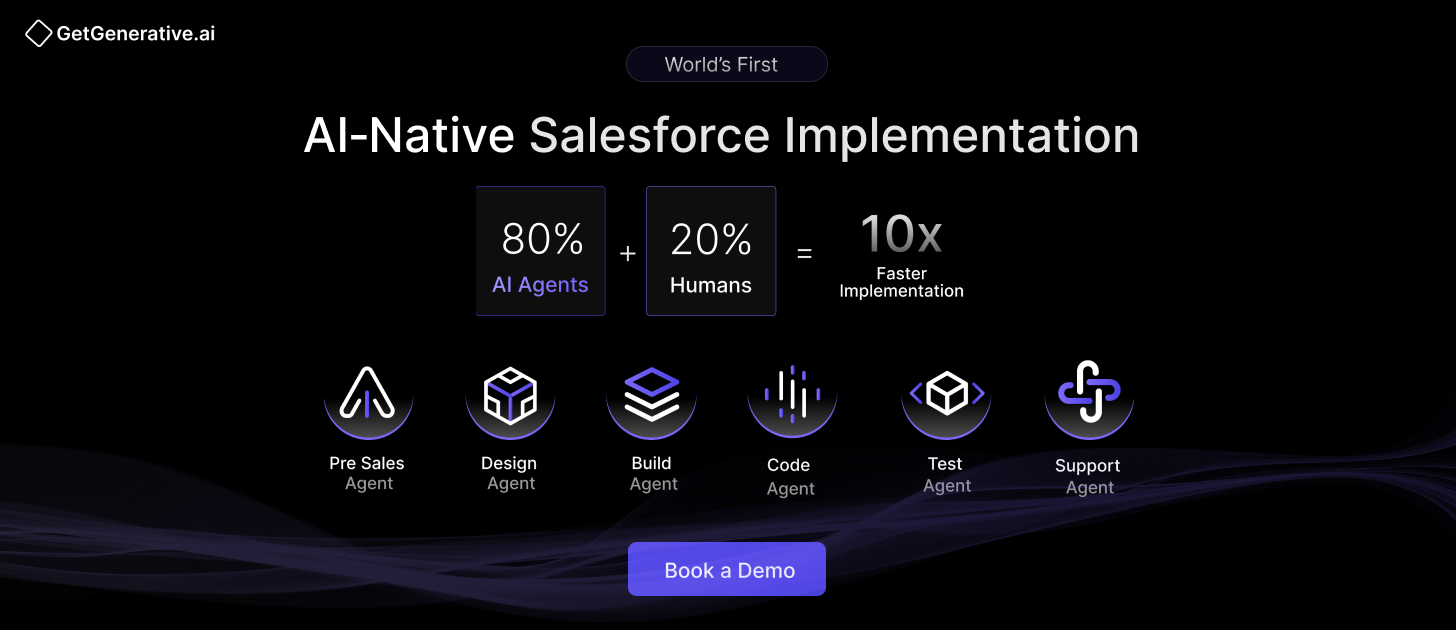Salesforce Commerce Cloud Implementation Guide 2025
The global e-commerce market is surging toward a projected $6.5 trillion in sales (eMarketer), presenting unprecedented opportunities for digital growth. While Salesforce Commerce Cloud serves both B2C and B2B use cases, this guide focuses on its powerful capabilities for B2B enterprises — where complexity, personalization, and integration matter most.
By 2026, over 53% of B2B sales will occur through digital channels (Salesforce), and 70% of B2B buyers now prefer to complete purchases online (Digital Commerce 360). This rapid evolution in buyer behavior demands more than just an online store — it calls for a platform that can deliver account-specific pricing, complex order workflows, and seamless CRM/ERP integration.
In this guide, we’ll explore what it takes to successfully implement Salesforce Commerce Cloud for B2B in 2025. From architecture decisions (traditional vs. headless vs. composable) to ERP/CRM integration — this comprehensive playbook is built to help Salesforce architects, IT leaders, and CXOs deliver measurable results from their B2B commerce initiatives.
Salesforce B2B Commerce Cloud
Salesforce Commerce Cloud has become a market leader in B2B digital commerce, recognized for both its robust feature set and seamless integration with Salesforce’s broader CRM ecosystem. In The Forrester Wave: B2B Commerce Solutions, Q2 2024, Salesforce was named a Leader, scoring highest in areas like customer account management, contract entitlements, and analytics
What sets Salesforce apart is its native connection to Sales Cloud, Service Cloud, and Data Cloud, enabling a true 360° customer view. This means your commerce channel isn’t siloed — it’s tightly integrated with your customer data, sales activities, and post-sale support workflows.
For B2B enterprises, this unified ecosystem is a game-changer: sales reps can see online orders, service agents can access past invoices, and marketers can personalize promotions — all from a single platform.
Core Capabilities of Salesforce B2B Commerce Cloud
✅ Account-Specific Experiences
B2B buyers expect personalization at the account level. Salesforce delivers this with:
Authenticated storefronts tailored to each customer or segment
Custom catalogs and contract-based pricing based on login credentials
Branded portals for key clients, allowing differentiated experiences across customer tiers
For example, a manufacturing firm can ensure that a distributor logging in sees only products relevant to their contract and industry, complete with pre-negotiated terms.
✅ Bulk Ordering and One-Click Reorders
Unlike consumer stores, B2B purchases often involve hundreds or even thousands of SKUs. SFCC supports:
Large cart sizes without performance lag
Quick reorder functionality for recurring purchases
Saved carts and shopping lists to streamline the buying process
This makes the platform ideal for industries like industrial goods or healthcare supplies where repeat bulk orders are the norm.
✅ Flexible Checkout Options
B2B checkout workflows are more complex than B2C. Out of the box, Salesforce supports:
Multiple payment types: PO, ACH, credit cards
Split shipments, staggered deliveries, and multi-location shipping
Approval flows for regulated purchases or budget thresholds
Buyers get the same control they expect from a traditional procurement process, but through a self-service digital interface.
✅ Unified Order Management and Service Integration
Orders placed online are automatically routed through:
Salesforce Order Management for fulfillment
Sales Cloud and Service Cloud for visibility across sales and support functions
This provides real-time order status, inventory insights, and support tracking — all under one roof. A sales rep can see what was ordered online last week and follow up in the same dashboard.
✅ Embedded Analytics and Einstein AI
With analytics built into the platform, you can:
Track buyer behavior and conversion metrics
Surface AI-powered product recommendations
Use predictive insights for merchandising and upselling
Salesforce’s Einstein AI goes beyond simple rules-based logic, adapting to patterns over time. This helps automate promotions, identify high-intent buyers, and boost average order value.
✅ Enterprise-Grade Scalability and Global Support
Built for large-scale commerce, the platform offers:
Multi-currency and multi-language support
High-volume transaction handling
Global inventory visibility
One standout example: Rochester Electronics onboarded over 200,000 SKUs and 10 billion inventory units into Commerce Cloud, with real-time updates and 100% data accuracy — demonstrating the platform’s scalability (RafterOne).
Product Quality and Platform Assurance in Salesforce Commerce Cloud
Salesforce Commerce Cloud is recognized as an enterprise-grade e-commerce platform with a strong reputation for product quality and operational assurance. As part of Salesforce’s core cloud infrastructure, Commerce Cloud benefits from:
99.9%+ uptime SLA, backed by a globally distributed architecture with failover and redundancy.
Continuous automated testing and validation of new features across thousands of org configurations before every release.
Quarterly release cycles with thorough pre-release documentation, regression testing, and sandbox previews to ensure platform stability.
Platform-wide monitoring for latency, data integrity, and transactional consistency, ensuring reliability for high-volume B2B operations.
Built-in support for testing and QA during implementation, including unit testing frameworks, sandbox environments, and API-level mocks for integration testing.
Salesforce also provides Trust Status dashboards publicly (trust.salesforce.com) for transparency around platform availability, planned maintenance, and incident history.
Together, these practices reflect Salesforce’s enterprise commitment to platform assurance, which is critical for high-stakes B2B commerce environments.
How to implement Salesforce Commerce Cloud?
Implementing Salesforce Commerce Cloud involves a systematic approach to ensure a successful and smooth transition to the platform. Here’s a detailed breakdown of the key steps involved in the implementation process:
Discovery and Planning:
- Conduct a thorough assessment of your current e-commerce system, identifying pain points, limitations, and areas for improvement.
- Define your business goals, target audience, and desired outcomes for the Salesforce Commerce Cloud implementation.
- Develop a detailed project plan outlining timelines, milestones, and resource allocation.
- To ensure a comprehensive approach, assemble a cross-functional team, including representatives from IT, marketing, sales, and customer service.
Design and Development:
- Customize the Salesforce Commerce Cloud platform to align with your brand’s visual identity and user experience requirements.
- Develop a responsive and mobile-friendly storefront, ensuring seamless navigation and easy product discovery.
- Integrate Salesforce Commerce Cloud with your existing systems, such as ERP, CRM, and PIM, to ensure data synchronization and streamlined operations.
- Implement extensions and customizations to meet your business needs, such as custom product configurators or loyalty program integrations.
- Set up payment gateways, tax calculations, and shipping options to facilitate smooth checkout processes.
Also Read – Salesforce CRM Implementation With AI
Data Migration:
- Map out your existing data structure and identify the data elements that need to be migrated to Salesforce Commerce Cloud.
- Cleanse and validate your data to ensure accuracy and consistency before migration.
- Utilize Salesforce Commerce Cloud’s data import tools and APIs to transfer your product, customer, and order data into the platform.
- Verify the accuracy and completeness of the migrated data through thorough testing and quality assurance.
Testing and Optimization:
- Conduct comprehensive testing of all functionalities, including product search, cart functionality, checkout process, and order management.
- Perform load testing to ensure the platform can handle expected traffic and transaction volumes.
- Optimize the storefront for performance, focusing on page load speed, image optimization, and caching techniques.
- Conduct user acceptance testing (UAT) to gather feedback from key stakeholders and make necessary adjustments.
- Implement analytics and tracking tools to monitor performance and gather insights for continuous improvement.
Training and Deployment:
- Develop a comprehensive training program for your team that covers all aspects of Salesforce Commerce Cloud, from basic navigation to advanced features.
- Conduct role-specific training sessions for different departments, such as merchandising, customer service, and fulfillment.
- Prepare detailed documentation and user guides to support ongoing learning and reference.
- Plan a phased deployment approach, starting with a soft launch to a limited audience before the full public launch.
- Monitor the platform closely during the initial launch period, promptly addressing any issues or concerns.
Ongoing Support and Maintenance:
- Establish a dedicated support team to handle any technical issues or customer inquiries related to the Salesforce Commerce Cloud platform.
- Regularly monitor system performance, security, and data integrity to ensure optimal operation.
- Stay updated with the latest Salesforce Commerce Cloud releases and updates, leveraging new features and enhancements.
- Continuously gather customer feedback and analytics insights to identify areas for improvement and optimization.
- Foster a continuous learning and innovation culture, encouraging your team to explore new ways to leverage Salesforce Commerce Cloud’s capabilities.
“Artificial intelligence and generative AI may be the most important technology of any lifetime.”
– Marc Benioff, Chair, CEO, and Co-Founder of Salesforce
Architecture Choices in 2025: Traditional vs. Headless vs. Composable
Let’s explore each path in depth, along with the trade-offs and real-world implications.
1. Traditional Salesforce Architecture (Out-of-the-Box)
The most common approach for B2B implementations is using Salesforce’s Experience Cloud templates, which include native UI components for product catalogs, checkout flows, and account management. This method offers:
Faster time to market — ready-to-use components accelerate deployment
Tight CRM integration — built-in sync with Sales and Service Cloud
Lower development overhead — fewer resources required to launch
This model is ideal for businesses looking for a standardized but reliable e-commerce experience, especially when CRM integration is a top priority. Organizations like manufacturing firms or distributors that don’t need pixel-perfect branding often prefer this path to minimize complexity.
🟢 Best for: Companies prioritizing rapid deployment, budget control, and CRM-native commerce
🔴 Limitations: Less front-end flexibility, limited customization options for UX/UI
2. Headless Commerce and Composable Architecture
Headless commerce refers to the decoupling of the front-end presentation layer from back-end commerce services. With Salesforce B2B APIs available for catalog, cart, checkout, accounts, and more, companies can:
Build custom front-end apps (e.g., React, Angular, mobile apps)
Support multiple customer touchpoints (dealer portals, mobile devices, kiosks)
Create highly personalized digital experiences
Closely related is composable commerce, which promotes assembling your digital commerce stack from best-of-breed services. A composable setup may include:
Salesforce Commerce Cloud for core commerce
A third-party CMS for content
Algolia or Coveo for advanced product search
Custom microservices for pricing, tax, or product configuration
🟢 Best for: Enterprises with highly specialized UX requirements, multi-channel digital strategies, or modular IT environments
🔴 Limitations: Higher development costs, longer time-to-market, and increased maintenance complexity
As Salesforce embraces the MACH principles (Microservices, API-first, Cloud-native, Headless), it’s becoming easier to build modular commerce solutions while retaining Salesforce’s reliability. Features like Composable Storefront accelerators and headless B2B API kits make this more accessible than ever before.
3. Hybrid Approach: The Best of Both Worlds
Many enterprises in 2025 are adopting a hybrid architecture — using Salesforce’s native Experience Cloud templates for workflows like checkout or account management, while deploying a custom front-end for more dynamic experiences like product discovery or content-heavy landing pages.
This model offers:
Faster go-lives for foundational workflows
Customization where it truly adds value
Streamlined integration with existing systems (via single sign-on and synced data models)
A typical example might include:
A React-based product browsing experience hosted on Heroku
Checkout and user account pages powered by Salesforce Experience Cloud
APIs facilitating a seamless handoff between systems
🟢 Best for: Enterprises seeking a balance of speed and flexibility
🔴 Considerations: Careful architecture planning is required to avoid silos
Making the Right Choice: Key Evaluation Criteria
| Decision Factor | Traditional (OOTB) | Headless / Composable | Hybrid Approach |
|---|---|---|---|
| Time to Market | Fastest (3–6 months) | Slowest (6–12+ months) | Moderate (4–8 months) |
| Customization | Limited UI control | Full front-end control | Selective customization |
| Cost of Implementation | Lower | High (requires dev resources) | Medium (balance of both) |
| Long-Term Flexibility | Moderate | High | High |
| CRM/ERP Integration | Built-in | Requires custom integrations | Selective integration points |
Integration Strategy: Unifying Commerce, ERP, and CRM in 2025
In enterprise B2B e-commerce, a compelling storefront experience is only one piece of the puzzle. True success comes from seamlessly connecting Commerce Cloud with backend systems like ERP, CRM, OMS, and even EDI platforms. These integrations ensure data consistency, operational efficiency, and the rich self-service experience modern B2B buyers expect.
Key Integration Points in Salesforce B2B Commerce
1. Product and Pricing Integration (ERP & PIM)
B2B product catalogs are massive and often governed by ERP or PIM systems. Salesforce B2B Commerce supports integration with systems like SAP, Oracle, or Informatica to ensure:
Real-time inventory availability
Contract-based pricing and volume discounts
Dynamic tax and shipping rate calculation
Example: An industrial supplier using SAP ERP can fetch live inventory and pricing at checkout via Salesforce’s Commerce Extensions framework, launched in Winter ’24. This allows external API calls (e.g., pricing engine or tax calculator) in real time — without disrupting the buyer experience.
2. Order Management and Fulfillment (ERP/OMS)
Once an order is placed, it must flow into the correct backend system — either an ERP or Salesforce Order Management (OMS). Salesforce OMS offers:
Order lifecycle management
Payment capture and invoicing
Smart fulfillment and routing logic
Real-World Win: Rochester Electronics achieved end-to-end order automation by integrating SFCC + Salesforce OMS + their legacy ERP through MuleSoft, resulting in seamless flow from online order to warehouse dispatch with zero manual intervention.
3. Customer and Account Sync (Salesforce CRM)
One of the biggest advantages of using Salesforce for B2B commerce is its native CRM integration:
Customers log in via their Salesforce Account and Contact records
Any updates to addresses, preferences, or orders are reflected instantly in Sales Cloud
Sales reps and service teams get full visibility into digital activity
Case in Point: FedEx unified web commerce data with CRM and shipping records via Salesforce Data Cloud, enabling personalized follow-ups and reducing customer churn.
4. External Sales Channels and EDI
B2B sales aren’t limited to web portals. Enterprises must support:
EDI transactions from large buyers
Orders from distributor portals and mobile apps
Marketplace integrations (e.g. Amazon Business)
Salesforce’s acquisition of MuleSoft and release of Anypoint Partner Manager has made these complex integrations more accessible. You can now:
Route EDI orders into Salesforce OMS
Maintain consistent pricing/inventory across channels
Provide full order visibility across all sales sources
Stat to Note: Over 75% of B2B digital sales still involve EDI, making integration a non-negotiable part of your architecture.
Best Practices for Integration Planning
| Area | Strategic Recommendation |
|---|---|
| Middleware Use | Use platforms like MuleSoft or Boomi to avoid point-to-point “spaghetti” integrations. Leverage Salesforce Accelerators for SAP, Oracle, NetSuite, etc. |
| Real-Time vs Batch | Use real-time APIs for pricing, stock, and order status. Batch sync for long-tail data (e.g., historical orders). |
| Data Governance | Clearly define source of truth for each entity: ERP for inventory, CRM for accounts. Avoid duplication or overrides. |
| Testing & Monitoring | Stress-test ERP API limits during peak periods (e.g., Black Friday). Use MuleSoft monitoring to trace and debug failures. |
| Error Resilience | Build fail-safes: if pricing API fails, display default prices. Ensure fallback workflows don’t disrupt the customer experience. |
Data Strategy and Analytics for B2B Commerce
A successful Salesforce Commerce Cloud implementation isn’t just about storefront functionality—it’s a data project at its core. Product catalogs, customer hierarchies, contract pricing, and user behavior all produce massive volumes of data. How that data is structured, governed, and activated will determine your ability to scale, personalize, and compete.
Product Data: The Foundation of Self-Service
Product data is the heartbeat of your B2B store. Large catalogs with thousands of SKUs demand:
Standardized names and specs
Rich descriptions and attributes
High-quality images, datasheets, and technical docs
A well-maintained catalog drives:
Search accuracy
Product confidence for buyers
Higher conversion rates
Best Practice: Cleanse and normalize product data before migration. If you use a PIM (Product Information Management) system, integrate it directly. If not, use Salesforce’s data model to standardize attributes and media storage.
Real-world insight: Many implementation challenges stem from inconsistent or incomplete product data — invest in this early.
Customer & Account Data: Building a Unified Profile
B2B customer data often exists across ERP, CRM, and legacy portals. To deliver a seamless experience, businesses must consolidate and reconcile this data into a single source of truth.
Use Salesforce CRM as the hub for accounts, contacts, and relationships
Leverage Salesforce Data Cloud to unify identity across systems
Sync address books, payment terms, and purchase history into one view
Case in Point: FedEx unified commerce, shipping, and engagement data to create a 360° customer profile — enabling better targeting, faster service, and predictive outreach.
Analytics and KPIs: Measure What Matters
To gauge performance and optimize the site, define metrics upfront. Key B2B KPIs include:
% of total orders placed online
Customer portal adoption rates
Average order value (AOV)
Repeat purchase frequency
Cart abandonment rate
Time to fulfillment
Salesforce provides out-of-the-box dashboards, and you can extend insights via:
CRM Analytics (Tableau CRM)
Third-party BI tools (e.g., Power BI, Looker)
Custom reports based on commerce, CRM, and OMS data
Example: If analytics show 20% of users abandon checkout on the payment page, it may signal poor UI, lack of payment options, or missing credit terms.
Benchmark tip: B2B e-commerce sales grew 17% YoY in 2023 (Digital Commerce 360), even when total industry revenue was flat — digital-first strategies are winning.
AI & Personalization: Going Beyond Static Rules
With Salesforce Einstein and Agentforce capabilities, B2B companies can now personalize at scale:
AI-powered product recommendations
Predictive search sorting based on intent
Promotional optimization based on segment behavior
Forecasting demand and replenishment timing
Early-stage implementations may begin with rules-based personalization (e.g., “If buyer is in industry X, show these products”) and evolve to AI-driven models as engagement data grows.
Pro Tip: Ensure your site has enough behavioral data (product views, clicks, order history) to train Einstein. Until then, use hybrid models combining AI + rules.
Data Governance and Compliance
Enterprise data strategy must also account for:
Data security and field-level access controls
GDPR and CCPA compliance
Audit trails and deletion requests (Right to be Forgotten)
Industry-specific regulations (e.g., HIPAA, export controls)
Salesforce supports field encryption, user roles, and compliance configurations out-of-the-box. Plan for:
Data residency requirements if operating globally
Backup and recovery protocols
Role-based permissions for internal and external users
B2B Commerce Cloud Implementation Checklist
Use this checklist as a practical project guide to ensure all critical tasks are covered during your Salesforce B2B Commerce implementation. Adapt it to your specific needs and phases.
Project Kickoff and Alignment
✅ Identify stakeholders (Exec sponsor, IT, sales, customer ops)
✅ Define KPIs (e.g., online order %, CSAT, AOV)
✅ Establish phased roadmap (e.g., Phase 1 for key accounts)
✅ Confirm budget for licenses, partners, middleware
Discovery and Requirements
✅ Map B2B customer journeys (login → reorder → support)
✅ Gather detailed feature and compliance requirements
✅ Perform gap analysis between OOTB vs. custom needs
✅ Finalize architecture (native, headless, hybrid)
Architecture and Design
✅ Define product/account/pricing data models
✅ Design system integration flow (ERP, OMS, CRM)
✅ Configure security model and roles
✅ Create solution architecture diagram for alignment
Data Preparation
✅ Cleanse and enrich product data (images, specs, docs)
✅ Prepare customer/account records for launch
✅ Load contract pricing and volume discount rules
✅ Execute and validate data migration plan
Build and Configuration
✅ Configure Salesforce orgs (Dev, UAT, Prod)
✅ Build storefront using Experience Builder or APIs
✅ Develop custom LWC components or services (if needed)
✅ Build and test integration flows (MuleSoft, APIs)
Testing
✅ Unit test all custom code (75%+ coverage)
✅ Conduct full functional testing (pricing, checkout, reorders)
✅ Validate integrations (ERP, OMS, etc.)
✅ Perform load/performance testing
✅ Complete UAT with sales and pilot customers
Training and Enablement
✅ Train internal teams (sales, service, support)
✅ Create customer training assets (videos, PDFs)
✅ Set up go-live support playbooks and escalation paths
Launch Preparation
✅ Final data migration and production deploy
✅ Optionally soft launch to pilot customers
✅ Monitor traffic, errors, API call volume
✅ Announce go-live with coordinated marketing campaign
✅ Open feedback channels for rapid iteration
Post-Go-Live Optimization
✅ Track adoption and performance metrics daily
✅ Run retrospective and lessons learned session
✅ Maintain enhancement backlog
✅ Provide ongoing training and documentation
✅ Stay aligned with Salesforce release roadmap
Conclusion
Salesforce Commerce Cloud offers B2B enterprises a robust, scalable, and intelligent platform to meet the rising expectations of digital-first buyers. But success in 2025 depends on more than just features — it requires leadership, strategic planning, and a commitment to execution excellence.
Want to spend less time stitching together spreadsheets and more time driving results?
With GetGenerative.ai, you can shape your entire Salesforce implementation — from proposal to go-live — in one connected workspace, powered by intelligent agents that understand your process.
If you’re looking for help with Salesforce implementation, explore our AI Salesforce Consulting Services for expert guidance tailored to your business.
If you’re planning your next rollout, it’s worth seeing what this looks like in action.
Frequently Asked Questions (FAQs)
1. How long does Salesforce Commerce Cloud implementation typically take?
The implementation timeline varies depending on the complexity of your project, but it generally ranges from 3-6 months.
2. Can Salesforce Commerce Cloud integrate with my existing systems?
Yes, Salesforce Commerce Cloud offers many APIs and integration options to connect with your existing systems, such as ERP, CRM, and PIM.
3. Is Salesforce Commerce Cloud suitable for B2B e-commerce?
Absolutely! Salesforce Commerce Cloud offers specific features and capabilities designed for B2B e-commerce, such as custom catalogs, price lists, and account management tools.
4. Can I customize the look and feel of my Salesforce Commerce Cloud storefront?
Yes, Salesforce Commerce Cloud provides extensive customization options, allowing you to tailor the design and user experience to match your brand’s unique style and requirements.
5. What level of support is available for Salesforce Commerce Cloud?
Salesforce offers a range of support options, including online resources, community forums, and dedicated support teams to help you with any questions or issues you may encounter during and after implementation.




